 |
  |
 |
published: April 12, "1994"
Jimi Hendrix :Blues CD Booklet by Michael Fairchild |

Previews & What's New
Jimi's Prediction —
A Remote View About Jimi Hendrix Timeline Blog Asteroid Impact Evolution Woodstock Blues Skewed Science Jimi Code VS. Da Vinci Code Credit Thefts Missile Agency/Moon Base Charade Seattleland Censorship Events Search Engine Rankings Download An Ad AT&T: New Nuremberg The Wall(y)flower Syndrome Rochester Media DVD/CD Store More Links... 
Page 5 of 10
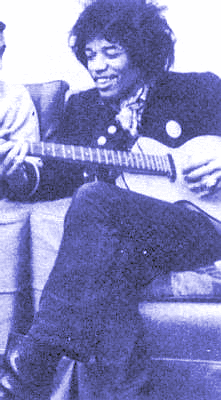 In New York in '66, when Hendrix began fronting his own band, he was approached by John Hammond Jr., son of the legendary record producer who had signed Bob Dylan and Aretha Franklin. John Hammond Jr. played blues and invited Jimi to showcase with him for many of the biggest names in '60s rock music. "I had all these Muddy Waters and Howlin' Wolf tunes on my So Many Roads album," recalled Hammond, "and Jimi had gotten them from my record, at least that's what he told me. I believe that when he came back (from '67 European success) to the States was the time he started to hear the blues for the first time. I'm sure as he got more and more well known, I became less and less important to his reality, and he had to say, 'Oh, I got this from Muddy Waters and Howlin' Wolf', which I can understand. But Robbie Robertson's guitar playing on that album is what really inspired him. Before that I think he'd been into an R&B scene completely. It wasn't until he came into being on his own that he began to play the blues. I might be wrong, but this is the impression that I had when I met Jimi."
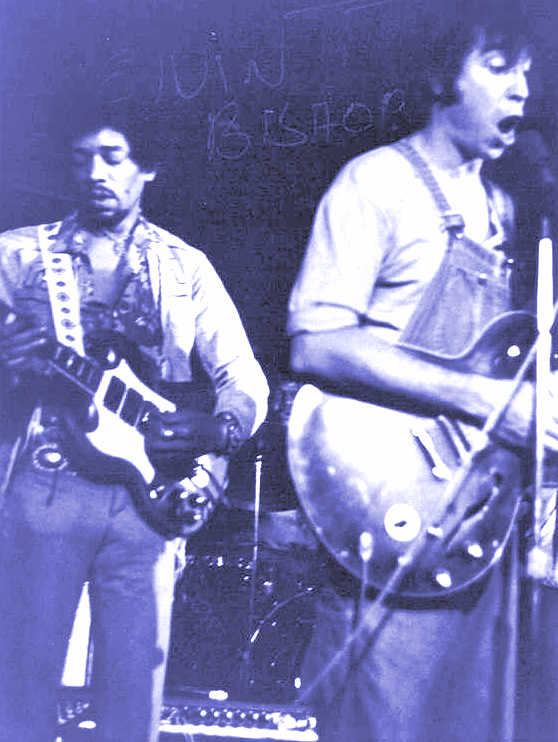 Jimi & Elvin Bishop Stephan Grossman is a blues musician who caught Jimi's gigs with Hammond and recalled, "His singing had a touch of Hooker and Muddy Waters, though I had the impression that Hendrix' biggest influence at the time was John Hammond." John Sebastian agrees, "He really dug John Hammond and wanted to get John Hammond records, and he really learned a lot of old blues off John Hammond records. So in a lot of ways Jimi is really unique second-generation." Why did Jimi lead Hammond and others to believe this? "Everything was very calculated with him," explains Paul Caruso. "He was very introspective about the moves he made. You could tell even when he met a person. There was an inner dialogue with himself about timing and what to say. He was being very careful, because he was damn sure he was going to be a rock and roll star. And so he used his humility, his 'aw, shucks' humility, it opened doors for him everywhere. It was so natural to him. It would have been laughable on anyone else."
Fayne & Jimi 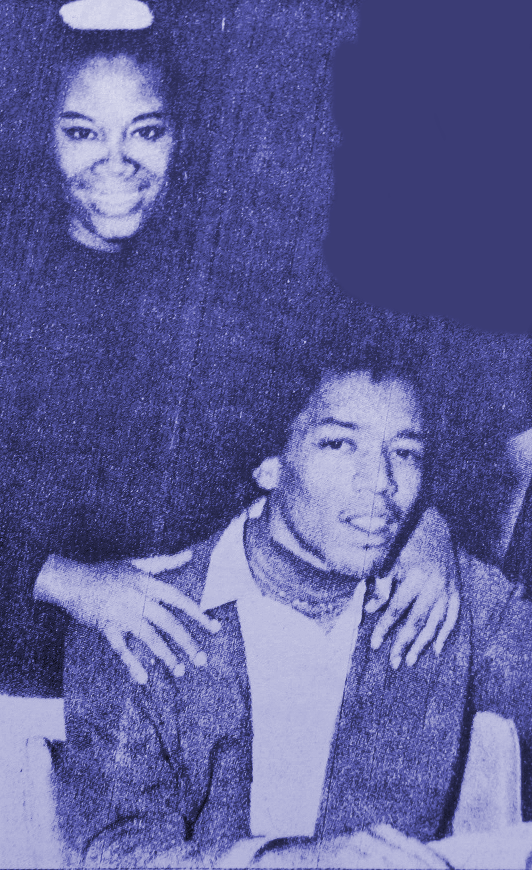 Did Jimi flatter Hammond while keeping in mind John Hammond Sr.'s position in the music business? Fayne Pridgeon was Jimi's Harlem lover the year before and she knew his musical tastes. When she introduced him to her mother she recalls, "He got all excited about her blues records. She had the low down stuff, Ruth Brown and beyond that. She had Muddy Waters, Lightnin' Hopkins, Judy King, Junior Parker, and folks like that and Jimi loved those people. He got out his guitar and played along with some of the records."
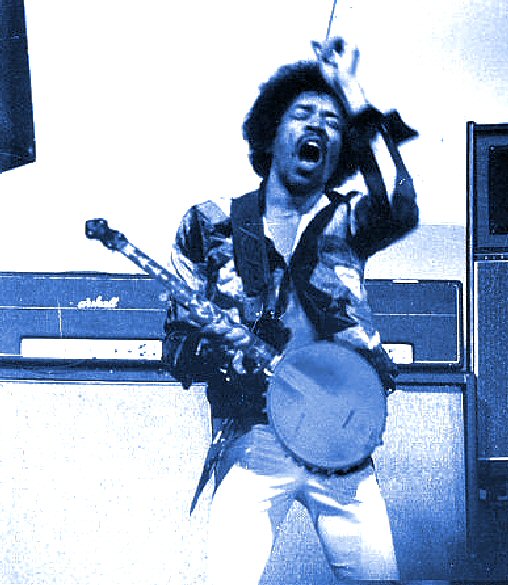 But Jimi decided to change his image in '66. "The old familiar faces began falling by the wayside," recalls Fayne. "Jimi lost his interest in the blues that had captured his attention at my mom's - no more B.B. King, Lil' Walter, and Howlin' Wolf that he used to be mad about. I felt betrayed when he brought a Bob Dylan album home. Not only did his music change color, but the color of his friends did too. I remember when he brought me to meet John Hammond and his parents, who were white. Everytime I looked twice at John, I felt Jimi digging his long bony fingers into my thigh under the table. John Hammond and his parents were the first of a new order of social acquaintances for Jimi." Hammond Sr. had recorded Bessie Smith and Billie Holiday, and in 1938 he tried to book Robert Johnson for the historic From Spirituals To Swing concert in Carnegie Hall, but Johnson died before he could accept the invitation, he was poisoned in a Mississsippi jukejoint. On March 6, 1942 the most powerful tornado ever to hit the Delta wiped that jukejoint off the face of the earth. Nine days short of nine months later, Jimi was born on November 27. It was as if that twister over Johnson's death site marked a Crossroads time-warp of the Hendrix conception. Reincarnated, the blues were personified in Jimi.
Robert Johnson 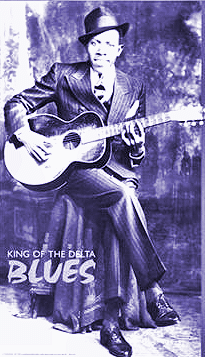 But the storm wasn't over. On the anniversary of Johnson's death, 30 years later, Jimi debuted his version of the National Anthem just south of the Mason-Dixie line in Columbia, Maryland. One year later he played the Anthem at Woodstock and the strongest hurricane ever seen in the west blew up the Delta's birthplace of the blues. Jimi played Voodoo Child and kissed the sky, long after Robert cut Crossroads on his birthday. So Hammond Sr. couldn't book Johnson, but 26 years later he got Son House instead. After Dick Waterman re-discovered Son House in '64, he brought him to Hammond to sign with Columbia, which already had the first Robert Johnson album in their catalog. Upon meeting Son House, Hammond Sr. gushed enthusiasm for "Robert Dusty" to such lengths that, as Waterman recalls, "When the waitress brought our drinks, I picked up my beer and proposed a toast. 'To John Hammond, for bringing Son to Columbia Records.' Son looked at me for a few seconds and then shook his head. He picked up his bourbon and smiled at me for the first time all day. 'To Robert Johnson, for being dead!'"
Jimi & Johnny Winter 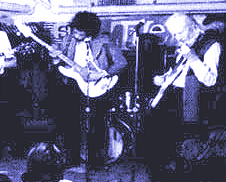 Rivalry among the blues affected Jimi too, especially after he became the world's first black superstar. Johnny Winter recalled when, "Jimi sang with Howlin' Wolf one night at the Scene, but Wolf really hurt his feelings bad. Many (blacks) felt that while he was playing with these young white British musicians, he should have been devoting himself to Black Power and his people. And so when he sat in with Howlin' Wolf, Wolf kind of put him down. This bothered Jimi because Wolf was one of his idols. 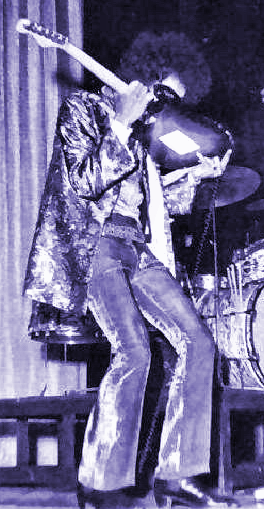 But Howlin' Wolf's guitarist, Hubert Sumlin, remembers an earlier encounter with Jimi. "We had to play a club and we got between a couple of numbers and in walked Jimi Hendrix. There was a lot of famous people there, I believe some of The Rolling Stones was there. He came on the stage and took the bandstand, and Wolf saw this guy coming with all these weird looking clothes and things on, and Wolf handed him his guitar and this guy went to playing with his teeth! And didn't Wolf offer him my job! I said uh-oh, I know I'm fired now! That's what I said to myself, just cracking a joke. On intermission they got together there and I got out of the way and I let them talk because Wolf was giving him advice. There's no need to be lying here, no, Wolf loved his Hendrix, man. Yes sir, he loved Jimi and he gave him some ideas, you know, what to do to make it. Jimi didn't have out no records then, but he was startin' and he wanted to play some blues. I know the guys got along fine."
|
| © 1994 First Century Press. All Rights Reserved. Contact Us |
